Carbon Dioxide or Solar Forcing?
By: Nir J. Shaviv
Natural or Anthropogenic? Which mechanism is responsible for global warming over the 20th century?
According to the common perception, the temperature over the 20th century has been warming, and it is mostly anthropogenic in origin, with greenhouse gases (GHGs) being the dominant driver. Others, usually called "skeptics", challenge this view and instead claim that the temperature variations are all part of natural variability. As I try to demonstrate below, the truth is probably somewhere in between, with natural causes probably being more important over the past century, whereas anthropogenic causes will probably be more dominant over the next century. Following empirical evidence I describe below, about 2/3's (give or take a third or so) of the warming should be attributed to increased solar activity and the remaining to anthropogenic causes.
Like many others, I was personally sure that CO2 is the bad culprit in the story of global warming. But after carefully digging into the evidence, I realized that things are far more complicated than the story sold to us by many climate scientists or the stories regurgitated by the media. In fact, there is much more than meets the eye.
The truth is that there is no real evidence for this link. Most of the "evidence" often mentioned in the media, is evidence for global warming (e.g., melting of arctic ice-sheets). But who said that this warming (which indeed took place over the 20th century) is because of GHGs? In fact, there is no substantial evidence which proves that CO2 and other GHGs are the primary cause for the warming, and not some other mechanism. You may have seen articles which point to the contrary, that there is clear evidence, but if you dig deeply into them, you will realize that these are merely suggestions for a CO2 climate link and not evidence.
The IPCC writes about fingerprinting the anthropogenic causes. In particular, their report states that (IPCC TAR §12.2.3):
Hence, using models to find fingerprints is hard. If you read the TAR (in particular, chapter 12), you will find claims that the different warming in northern vs. southern latitudes, and tropospheric vs. stratospheric warming can be explained using anthropogenic GHGs operating together with sulphate aerosols, stratospheric ozone and even solar (total irradiance) forcing. Namely, the combination of the drivers can do a descent job in explaining the warming (IPCC TAR §12.4.3.2):
But in itself it is not proof that GHGs are the major cause. These consistent results only indicate that CO2 can explain the warming, not that it is the only possible explanation. Without other "suspects", it would be incriminating circumstantial evidence. However another very good candidate to explain a large fraction of the warming does exist, as I explain below.
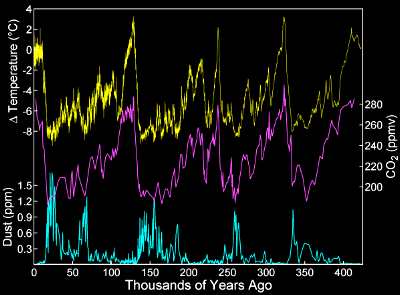 Of course, the beautiful correlation between CO2 reconstructions
and temperature on Earth over the multi-millennial time scale, as it apparent in the figure, is often used to demonstrate how CO2 plays a role in large climate variations. This often misleads the laymen to believe that CO2 is the climate driver, whereas in fact it could be the opposite, that the global temperature affects the equilibrium levels of CO2. In reality it could be somewhere in between, that CO2 is affected by the temperature and that it in turn causes a larger temperature variation. Just by itself, however, this correlation cannot be used to quantify the effect of CO2 on the climate, which could be anywhere from no effect to all the effect. Thus, it is no proof that CO2 is the main cause of the variations over the 20th century. There is no such evidence.
Of course, the beautiful correlation between CO2 reconstructions
and temperature on Earth over the multi-millennial time scale, as it apparent in the figure, is often used to demonstrate how CO2 plays a role in large climate variations. This often misleads the laymen to believe that CO2 is the climate driver, whereas in fact it could be the opposite, that the global temperature affects the equilibrium levels of CO2. In reality it could be somewhere in between, that CO2 is affected by the temperature and that it in turn causes a larger temperature variation. Just by itself, however, this correlation cannot be used to quantify the effect of CO2 on the climate, which could be anywhere from no effect to all the effect. Thus, it is no proof that CO2 is the main cause of the variations over the 20th century. There is no such evidence.
As far as I see it, there are two main reasons why GHGs are blamed as the main cause of global warming even through there is no real incriminating evidence:
As to the second point, there is another good mechanism to blame, that of indirect solar forcing. This mechanism can do just as good a job in explaining 20th century warming as CO2, if not a better one.
On average, every square meter of the global surface receives a flux about 240 Watts per square meter. Of course, equatorial surfaces receive more than polar regions, which is why this figure for the radiative flux is an average.
The climatic effect of different global processes is usually quantified with their contribution to a net change in the average radiative flux. For example, doubling the amount of CO2 in the atmosphere changes the radiative budget by about 4 W/m² (3.8 W/m² to be more exact), as if the sun was 4/240*100=1.7% brighter.
The scientific report of the Intergovernmental panel for climate change (IPCC) attempts to summarize the effects of all the drivers. This is displayed in the famous forcing graph below. There are several interesting points one should note. First, there is a large uncertainty in an anthropogenic contribution called the indirect aerosol effect. This effect arises from the fact that increased amounts of small particles in the atmosphere will alter the characteristics of clouds. This is best seen downstream of chimney stacks or in marine clouds in the form of ship tracks. Since cloud formation, and in particular, the characteristics of clouds, is not well understood, the indirect aerosol effect is highly uncertain. The second point to note is that the solar forcing quoted by the IPCC is 0.3 W/m². This does not include the effect of the solar modulated cosmic ray flux, which has ample evidence to support it, and no real evidence to refute it. If one includes the effects of cosmic rays, an additional 1 W/m² should be added because of the increased solar activity (which reduced the flux of cosmic rays reaching Earth, as will be explained below).
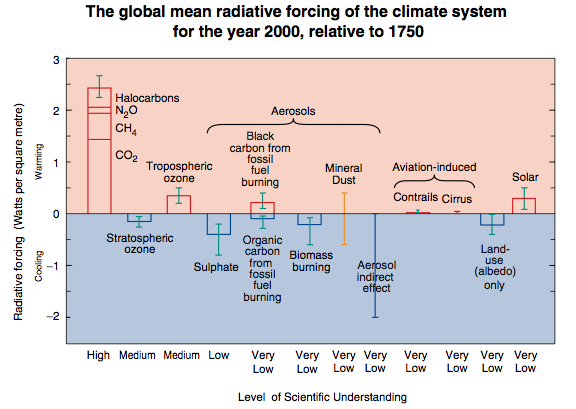 Evidently, we do not know the total Anthropogenic forcing. We don't know
its sign. We also don't know its magnitude. All we can say is that it
should be somewhere between -1 to +2 W/m². Sounds strange, but we may
have actually been cooling Earth (though less likely than warming). It is
for this reason that in the 1970's, concerns were raised that humanity is cooling the global temperature. The global temperature appeared to drop between the 1940's and
1970's, and some thought that anthropogenic aerosols could be the cause of
the observed global cooling, and that we may be triggering a new ice-age (e.g., see wikiepdia for a summary)
Evidently, we do not know the total Anthropogenic forcing. We don't know
its sign. We also don't know its magnitude. All we can say is that it
should be somewhere between -1 to +2 W/m². Sounds strange, but we may
have actually been cooling Earth (though less likely than warming). It is
for this reason that in the 1970's, concerns were raised that humanity is cooling the global temperature. The global temperature appeared to drop between the 1940's and
1970's, and some thought that anthropogenic aerosols could be the cause of
the observed global cooling, and that we may be triggering a new ice-age (e.g., see wikiepdia for a summary)
The problem with numerical simulations of climate is that the feedbacks, especially those pertaining to cloud cover, are very poorly understood. As a result, any value in the range of Tx2≈1.5-4.5°C is believed to be possible according to the IPCC. In other words, based on theory (well, numerical simulations to be more exact), the temperature change associated with doubled CO2 is not known to within a factor of 3!
Clearly, the incrimination of CO2 (and other GHGs) is primarily because we expect it to warm (see fig. 4), and we do see warming (see fig. 3), but it turns out that there are other suspects.
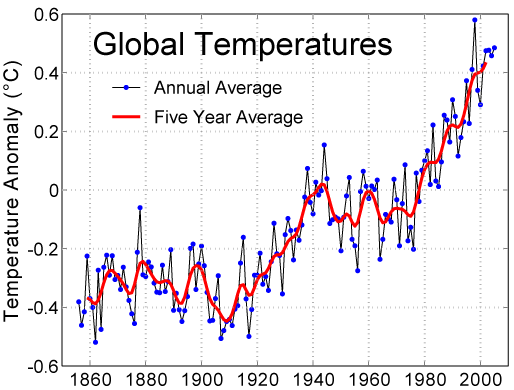
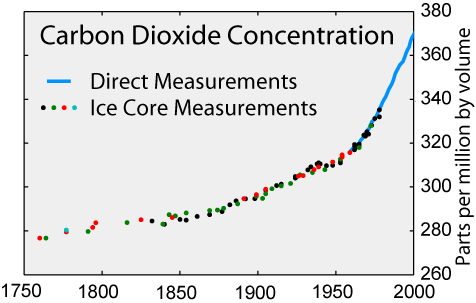
Because the solar correlated climate variations are large, but the total solar irradiance variations are relatively small (a few 0.1%), the latter are most likely not the explanation of climate variability. Instead, different amplifying mechanisms were suggested, mechanisms which can amplify the non-thermal components of the sun (e.g., UV, X-ray, solar wind) and which can considerably vary between an active sun and a quiet one.
The leading mechanism to explain the large solar induced climate variability is through solar wind modulation of the cosmic ray flux reaching the Earth, which affects climate through modulation of the amount of atmospheric ionization. Over the past decade, many different pieces of evidence added up to a pretty coherent picture.
The activity of the sun manifests its self in many ways. One of them is through a variable solar wind. This flux of energetic particles and entangled magnetic field flows outwards from the sun, and impedes on a flux of more energetic particles, the cosmic rays, which come from outside the solar system. Namely, a more active sun with a stronger solar wind will attenuate the flux of cosmic rays reaching Earth. The key point in this picture is that the cosmic rays are the main physical mechanism controlling the amount of ionization in the troposphere (the bottom 10 kms or so). Thus, a more active sun will reduce the flux of cosmic rays, and with it, the amount of tropospheric ionization. As it turns out, this amount of ionization affects the formation of condensation nuclei required for the formation of clouds in clean marine environment. A more active sun will therefore inhibit the formation of cloud condensation nuclei, and the resulting low altitude marine clouds will have larger drops, which are less white and live shorter, thereby warming Earth.
Today, there is ample evidence to support this picture (a succinct introduction can be found here). For example, it was found that independent galactic induced variations in the cosmic ray flux, which have nothing to do with solar activity do too affect climate as one should expect from such a link. There are many more examples. [Added Note (4 Oct. 2006): These recently published experimental results stroingly point towards the validity of this link, as expected]
So why is this link important for global warming? As previously mentioned, solar activity has been increasing over the 20th century. This can be seen in fig. 5. Thus, we expect warming from the reduced flux of cosmic rays. Moreover, since the cosmic ray flux actually had a small increase between the 1940's and 1970's (as can be seen in the ion chamber data in fig. 6), this mechanism also naturally explains the global temperature decrease which took place during the same period.
Using historic variations in climate and the cosmic ray flux, one can actually quantify empirically the relation between cosmic ray flux variations and global temperature change, and estimate the solar contribution to the 20th century warming. This contribution comes out to be 0.5±0.2°C out of the observed 0.6±0.2°C global warming (Shaviv, 2005).
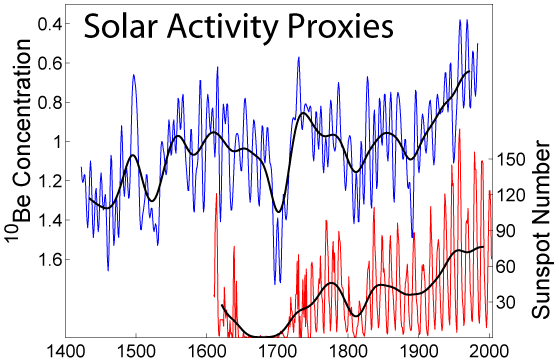
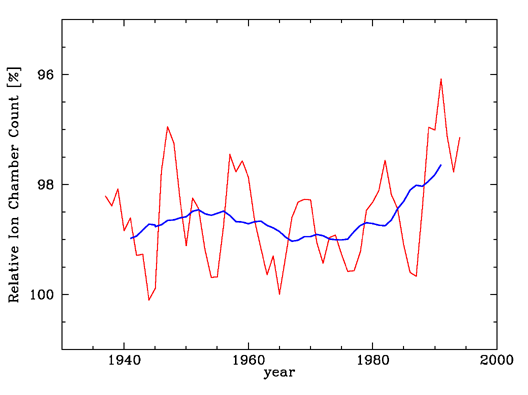
Although this reasoning seems logical, it turns out that (1) We don't even know the sign of the anthropogenic climate driving (because of the unknown indirect aerosol effects), and (2) There is an alternative mechanism which can explain a large part of the warming.
Solar activity can explain a large part of the 20th century global warming, on condition that there is a strong solar/climate link through modulation of the cosmic ray flux and the atmospheric ionization. Evidence for such a link has been accumulating over the past decade, and by now, it is unlikely that it does not exist.
This link also implies that Earth's global temperature sensitivity is also on the low side. Thus, if we double the amount of CO2 by 2100, we will only increase the temperature by about 1°C or so. This is still more than the change over the past century. This is good news, because it implies that future increases in the amount of atmospheric greenhouse gases will not dramatically increase the global temperature, though GHGs will probably be the dominate climate driver.
The two primary reasons why fossil fuels are bad are of course pollution and depletion, while minor reasons include for example the fact that many fossil fuel reserves are controlled by unpleasant governments.
Thus, I am very much in favor, and always have been, in using less fossil fuels and keeping the environment clean (I am proud to say that I grew up in a solar house), but we should do things for the right reasons, not the wrong ones (and I don't see Kyoto addressing the right reasons). I am therefore in favor of developing cheap alternatives such as solar power, wind, and of course fusion reactors (converting Deuterium into Helium) which we should have in a few decades, but this is an altogether different issue.
Natural or Anthropogenic? Which mechanism is responsible for global warming over the 20th century?
According to the common perception, the temperature over the 20th century has been warming, and it is mostly anthropogenic in origin, with greenhouse gases (GHGs) being the dominant driver. Others, usually called "skeptics", challenge this view and instead claim that the temperature variations are all part of natural variability. As I try to demonstrate below, the truth is probably somewhere in between, with natural causes probably being more important over the past century, whereas anthropogenic causes will probably be more dominant over the next century. Following empirical evidence I describe below, about 2/3's (give or take a third or so) of the warming should be attributed to increased solar activity and the remaining to anthropogenic causes.
Like many others, I was personally sure that CO2 is the bad culprit in the story of global warming. But after carefully digging into the evidence, I realized that things are far more complicated than the story sold to us by many climate scientists or the stories regurgitated by the media. In fact, there is much more than meets the eye.
What is the evidence for an anthropogenic effect?
The first question we wish to address is whether there is actual evidence indicating that greenhouse gases (GHGs) are responsible for most of the warming. Basically, we observe a temperature rise over the 20th century, and we measure a rise in the global concentration of CO2 and other anthropogenic greenhouse gases. What is the evidence proving that the increase in the GHGs is the cause for the temperature increase?The truth is that there is no real evidence for this link. Most of the "evidence" often mentioned in the media, is evidence for global warming (e.g., melting of arctic ice-sheets). But who said that this warming (which indeed took place over the 20th century) is because of GHGs? In fact, there is no substantial evidence which proves that CO2 and other GHGs are the primary cause for the warming, and not some other mechanism. You may have seen articles which point to the contrary, that there is clear evidence, but if you dig deeply into them, you will realize that these are merely suggestions for a CO2 climate link and not evidence.
The IPCC writes about fingerprinting the anthropogenic causes. In particular, their report states that (IPCC TAR §12.2.3):
“Different models may give quite different patterns of response for the same forcing, but an individual model may give a surprisingly similar response for different forcings. The first point means that attribution studies may give different results when using signals generated from different models. The second point means that it may be more difficult to distinguish between the response to different factors than one might expect, given the differences in radiative forcing.”
Hence, using models to find fingerprints is hard. If you read the TAR (in particular, chapter 12), you will find claims that the different warming in northern vs. southern latitudes, and tropospheric vs. stratospheric warming can be explained using anthropogenic GHGs operating together with sulphate aerosols, stratospheric ozone and even solar (total irradiance) forcing. Namely, the combination of the drivers can do a descent job in explaining the warming (IPCC TAR §12.4.3.2):
“In summary, the fixed pattern studies indicate that the recent warming is unlikely (bordering on very unlikely) to be due to internal climate variability. A substantial response to anthropogenic greenhouse gases appears to be necessary to account for recent temperature trends but the majority of studies indicate that greenhouse gases alone do not appear to be able to provide a full explanation. Inclusion of the response to the direct effect of sulphate aerosols usually leads to a more satisfactory explanation of the observed changes, although the amplitude of the sulphate signal depends on the model used. These studies also provide some evidence that solar variations may have contributed to the early century warming.”
But in itself it is not proof that GHGs are the major cause. These consistent results only indicate that CO2 can explain the warming, not that it is the only possible explanation. Without other "suspects", it would be incriminating circumstantial evidence. However another very good candidate to explain a large fraction of the warming does exist, as I explain below.

Fig. 1: Correlation between atmospheric CO2 and climate. Nope, it is not proof that CO2 is a major climate driver, since CO2 can be driven by temperature changes. Specifically, warmer oceans requires larger atmospheric partial pressures of CO2 to contain the dissolved gas in them. Of course, some of the temperature could be the result of CO2 amplifications, but there is no way of knowing what fraction.
As far as I see it, there are two main reasons why GHGs are blamed as the main cause of global warming even through there is no real incriminating evidence:
- Based on theory, increased levels of GHGs are expected to increase the global temperature.
- There is no other mechanism to blame for the warming. Without any other candidate, the only suspect, i.e. GHGs, must be the cause.
As to the second point, there is another good mechanism to blame, that of indirect solar forcing. This mechanism can do just as good a job in explaining 20th century warming as CO2, if not a better one.
The anthropogenic driving - How much is it?
If we wish to assess theoretically, how much is the anthropogenic contribution to 20th century warming, we have to address two questions, how much is the anthropogenic contribution to the changed radiation budget, and how changes in the radiation budget affect the global temperature. We begin with the anthropogenic contribution.On average, every square meter of the global surface receives a flux about 240 Watts per square meter. Of course, equatorial surfaces receive more than polar regions, which is why this figure for the radiative flux is an average.
The climatic effect of different global processes is usually quantified with their contribution to a net change in the average radiative flux. For example, doubling the amount of CO2 in the atmosphere changes the radiative budget by about 4 W/m² (3.8 W/m² to be more exact), as if the sun was 4/240*100=1.7% brighter.
The scientific report of the Intergovernmental panel for climate change (IPCC) attempts to summarize the effects of all the drivers. This is displayed in the famous forcing graph below. There are several interesting points one should note. First, there is a large uncertainty in an anthropogenic contribution called the indirect aerosol effect. This effect arises from the fact that increased amounts of small particles in the atmosphere will alter the characteristics of clouds. This is best seen downstream of chimney stacks or in marine clouds in the form of ship tracks. Since cloud formation, and in particular, the characteristics of clouds, is not well understood, the indirect aerosol effect is highly uncertain. The second point to note is that the solar forcing quoted by the IPCC is 0.3 W/m². This does not include the effect of the solar modulated cosmic ray flux, which has ample evidence to support it, and no real evidence to refute it. If one includes the effects of cosmic rays, an additional 1 W/m² should be added because of the increased solar activity (which reduced the flux of cosmic rays reaching Earth, as will be explained below).

Fig. 2:
Anthropogenic and Natural contributions to the net radiative forcing.
Figure from the IPCC TAR. If one adds their numbers (which are supposed to capture the
community's consensus, one finds an Anthropogenic forcing of: 0.8 ±
1.3 W/m² (where the errors were added in quadrature, assuming
independence). In other words, the large uncertainty in the indirect
aerosol effects, implies that the sign of the Anthropogenic
contribution is unknown!
Climate Sensitivity
Next, if we wish to translate the anthropogenic contribution to the radiative budget (assuming we knew it!) into a global temperature change, we need to know the global climate sensitivity. That is, we need to know the change λ in °C associated with a radiative forcing of 1 W/m². It can also be quantified with ΔTx2, which is the temperature increase associated with doubling the amount of CO2, i.e., a change of 3.8 W/m² in the radiative budget. If Earth behaved as an ideal black body, its sensitivity would be &lambda≈0.3°C/(W/m²), or ΔTx2≈1.2°C. However, Earth's sensitivity does not necessarily behave like that of an ideal black body. The reason is that as the temperature changes, other variables affecting the temperature change as well. For example, increasing the radiation budget, increases the temperature. This will increase the amount of water vapor in the atmosphere. However, water vapor is a great GHG. So, this will tend to increase the temperature further, thus giving rise to a positive feedback, which increases the sensitivity. On the other hand, the larger amounts of water vapor in the atmosphere imply more cloud cover. Since clouds have a net tendency to cool, this will counter the increase in temperature, thus giving rise to a negative feedback that decreases the sensitivity.The problem with numerical simulations of climate is that the feedbacks, especially those pertaining to cloud cover, are very poorly understood. As a result, any value in the range of Tx2≈1.5-4.5°C is believed to be possible according to the IPCC. In other words, based on theory (well, numerical simulations to be more exact), the temperature change associated with doubled CO2 is not known to within a factor of 3!
So, can CO2 be incriminated?
Evidently, according to the scientists behind the IPCC report, i.e., those who support Kyoto:- It is not clear how much is the actual anthropogenic contribution to a changed radiation budget (again, even the sign of the anthropogenic effect is not known).
- Even if the anthropogenic radiative forcing was better known, it is theoretically unclear by how much the temperature should have varied in response.
Clearly, the incrimination of CO2 (and other GHGs) is primarily because we expect it to warm (see fig. 4), and we do see warming (see fig. 3), but it turns out that there are other suspects.

Fig. 3:
Global Warming over the 20th century. Half the increase took place in the beginning of the previous century, long before the bulk of the human influence took place. Is this warming anthropogenic or natural? (image source:
Wikipedia)

Fig. 4: Carbon Dioxide in the atmosphere. Just like the global temperature, it increased over the 20th century. Since theoretically we expect the gas to warm, it is often incriminated as the main culprit behind global warming. But there is no direct evidence proving that it is it which is the primary warmer and not another mechanism.
(image source:
Wikipedia)
An alternative explanation for global warming, or at least part of it
Solar activity appears to affect climate. This can be seen from many different correlations between solar activity on one hand, and climate on the other. These correlations exist on time scales ranging from the 11-year solar cycle to many millennia (for the two most beautiful correlations, see Neff et al, and Bond et al. in the refs below). Such a link is potentially important for global warming because over the 20th century, solar activity has been increasing.Because the solar correlated climate variations are large, but the total solar irradiance variations are relatively small (a few 0.1%), the latter are most likely not the explanation of climate variability. Instead, different amplifying mechanisms were suggested, mechanisms which can amplify the non-thermal components of the sun (e.g., UV, X-ray, solar wind) and which can considerably vary between an active sun and a quiet one.
The leading mechanism to explain the large solar induced climate variability is through solar wind modulation of the cosmic ray flux reaching the Earth, which affects climate through modulation of the amount of atmospheric ionization. Over the past decade, many different pieces of evidence added up to a pretty coherent picture.
The activity of the sun manifests its self in many ways. One of them is through a variable solar wind. This flux of energetic particles and entangled magnetic field flows outwards from the sun, and impedes on a flux of more energetic particles, the cosmic rays, which come from outside the solar system. Namely, a more active sun with a stronger solar wind will attenuate the flux of cosmic rays reaching Earth. The key point in this picture is that the cosmic rays are the main physical mechanism controlling the amount of ionization in the troposphere (the bottom 10 kms or so). Thus, a more active sun will reduce the flux of cosmic rays, and with it, the amount of tropospheric ionization. As it turns out, this amount of ionization affects the formation of condensation nuclei required for the formation of clouds in clean marine environment. A more active sun will therefore inhibit the formation of cloud condensation nuclei, and the resulting low altitude marine clouds will have larger drops, which are less white and live shorter, thereby warming Earth.
Today, there is ample evidence to support this picture (a succinct introduction can be found here). For example, it was found that independent galactic induced variations in the cosmic ray flux, which have nothing to do with solar activity do too affect climate as one should expect from such a link. There are many more examples. [Added Note (4 Oct. 2006): These recently published experimental results stroingly point towards the validity of this link, as expected]
So why is this link important for global warming? As previously mentioned, solar activity has been increasing over the 20th century. This can be seen in fig. 5. Thus, we expect warming from the reduced flux of cosmic rays. Moreover, since the cosmic ray flux actually had a small increase between the 1940's and 1970's (as can be seen in the ion chamber data in fig. 6), this mechanism also naturally explains the global temperature decrease which took place during the same period.
Using historic variations in climate and the cosmic ray flux, one can actually quantify empirically the relation between cosmic ray flux variations and global temperature change, and estimate the solar contribution to the 20th century warming. This contribution comes out to be 0.5±0.2°C out of the observed 0.6±0.2°C global warming (Shaviv, 2005).

Fig. 5: Solar activity over the past several centuries can be reconstructed using different proxies. These reconstructions demonstrate that 20th century activity is unparalleled over the past 600 years (previously high solar activity took place around 1000 years ago, and 8000 yrs ago). Specifically, we see sunspots and 10Be. The latter is formed in the atmosphere by ~1GeV cosmic rays, which are modulated by the solar wind (stronger solar wind → less galactic cosmic rays → less 10Be production). Note that both proxies do not capture the decrease in the high energy cosmic rays that took place since the 1970's, but which the ion chamber data does (see fig. 6).
(image source:
Wikipedia)

Fig. 6: The flux of cosmic rays reaching Earth, as measured by ion chambers. Red line - annual averages, Blue line - 11 yr moving average. Note that ion chambers are sensitive to particles at relatively high energy (several 10's of GeV, which is higher than the energies responsible for the atmospheric ionization [~10 GeV], and much higher than the energies responsible for the 10Be production [~1 GeV]). Plot redrawn using data from Ahluwalia (1997). Moreover, the decrease in high energy cosmic rays since the 1970's is less pronounced in low energy proxies of solar activity, implying that cosmogenic isotopes (such as 10Be) or direct solar activity proxies (e.g., sun spots, aa index, etc) are less accurate in quantifying the solar → cosmic ray → climate link and its contribution to 20th century global warming.
Summary
As explained above, there is no real direct evidence which can be used to incriminate anthropogenic greenhouse gases as the being the main factor responsible for the observed global warming. The reason these gases were blamed are primarily because (1) we expect them to warm and indeed the global temperature increased, and (2) there is no other mechanism which can explain the warming.Although this reasoning seems logical, it turns out that (1) We don't even know the sign of the anthropogenic climate driving (because of the unknown indirect aerosol effects), and (2) There is an alternative mechanism which can explain a large part of the warming.
Solar activity can explain a large part of the 20th century global warming, on condition that there is a strong solar/climate link through modulation of the cosmic ray flux and the atmospheric ionization. Evidence for such a link has been accumulating over the past decade, and by now, it is unlikely that it does not exist.
This link also implies that Earth's global temperature sensitivity is also on the low side. Thus, if we double the amount of CO2 by 2100, we will only increase the temperature by about 1°C or so. This is still more than the change over the past century. This is good news, because it implies that future increases in the amount of atmospheric greenhouse gases will not dramatically increase the global temperature, though GHGs will probably be the dominate climate driver.
A clarifying note
So, as you may understand, I am quite sure Kyoto is not the right way to go. I should however stress that there are a dozen good reasons why we should strive to burn less fossil fuels.The two primary reasons why fossil fuels are bad are of course pollution and depletion, while minor reasons include for example the fact that many fossil fuel reserves are controlled by unpleasant governments.
Thus, I am very much in favor, and always have been, in using less fossil fuels and keeping the environment clean (I am proud to say that I grew up in a solar house), but we should do things for the right reasons, not the wrong ones (and I don't see Kyoto addressing the right reasons). I am therefore in favor of developing cheap alternatives such as solar power, wind, and of course fusion reactors (converting Deuterium into Helium) which we should have in a few decades, but this is an altogether different issue.
More Reading Material
- A short exposé about the evidence for cosmic rays and climate can be found in this non-technical article. In a while, a details summary of all the evidence pointing to a cosmic ray climate link will appear on this site.
- More on the empirical determinations of Earth's climate sensitivity, and in particular, the role of cosmic rays, can be found here (somewhat technical).
- The best example of cosmic rays flux induced climate variations, which are not related to solar activity, are the passages of the solar system through the milky way's spiral arms and the clear paleoclimate signal observed.
Notes and References
- All the information about the evidence for global warming, about the anthropogenic climate drivers, and about the numerical models can be found in the Scientific Reports of the Intergovernmental Panel for Climate Change (IPCC). Their reports do not include deficient with regards to all which is related to solar forcing.
- Perhaps the most beautiful correlation between a solar activity and climate proxies can be found in the work of U. Neff et al., "Strong coherence between solar variability and the monsoon in Oman between 9 and 6 kyr ago", Nature 411, 290 (2001).
- Another beautiful correlation between solar activity and climate can be seen in the work of G. Bond et al., "Persistent Solar Influence on North Atlantic Climate During the Holocene", Science, 294, 2130-2136, (2001).
- The detailed analysis behind the empirical determinations of Earth's climate sensitivity, and in particular, the role of cosmic rays, can be found in: Shaviv N., "On Climate Response to Changes in the Cosmic Ray Flux and Radiative Budget" JGR-Space, vol. 110, A08105, 2005, (PDF).

Comments (61)
Bob,
I agree with the reasoning, exept using the word "reflected mirrorlike", when it in fact is absorption followed by "black body radiation". And, not all of the radiation from the CO2 molecules will be radiated back from the ocean to the atmosphere, some of that heat will be convected and conducted downward in the water, from the surface.
Pages